MONDAY
JULY 17 - 2017
Brook
Meadow news
On my regular
morning walk through Brook Meadow, I stopped to admire
the tall cylindrical spikes of Timothy grass
which is flowering and now widespread on the meadow.
It flowers later in the year than most other grasses.
It is named after Timothy Hanson, an American farmer
and agriculturalist, who introduced it to Britain in
around 1720 where it became a major source of hay and
cattle fodder for British farmers. Here is a photo of
some on the Lumley area.

As far as height goes,
Timothy has some way to catch up with Reed
Canary-grass which towers over all other grasses
on the meadow. This magnificent grass is a robust
perennial whose roots go deep into the soil. It is
tolerant of periodic cutting and grazing and has been
used in the past as a hay or pasture grass for areas
subject to flooding, but not now? There are several
good patches of Reed Canary-grass around Brook Meadow
which are a striking feature of the grassland. Here is
a photo of some in the centre meadow looking east
towards the Lumley copse.

Creeping
Thistles seem to be having a good year. They are
abundant and flowering in several parts of the meadow.
I had a sniff at some flowers and found them
surprisingly aromatic. They certainly are very
attractive to insects. This Comma was having a good
feed.

I was surprised to see
this plant of Wild Angelica rising above the
rampant grasses on the north meadow. It is far more
common on the Lumley area and south meadow. The red
stems and rounded umbels are distinctive.

I was puzzled by a
tiny plant growing in the gap in the central Willow
line, no more than 4 inches tall with a single tiny
yellow flower with 4 petals at the top. I guess it
belongs to the brassica family, but which species?

Millpond
News
I had a quick
walk down to Slipper Millpond. Two large Grey
Mullett were basking in the shallow water beneath
the footbridge at the north end of Peter Pond. Shoals
of smaller fish were swimming around in Slipper
Millpond beneath the Hermitage Bridge.

Golden Samphire
is looking good on the Hermitage Bridge.

The remaining 5
swan cygnets were with their mother on Peter Pond
near the seat, while their father did his best to
chase off some Mallard that got too close.

Waysides
News
I did a big
litter pick in Bridge Road car park in the quiet of
yesterday evening, filling three large bags of rubbish
plus a bag of bottles. Here they are still awaiting
collection.

SATURDAY
JULY 15 - 2017
Havant
Wildlife Group
This morning
11 members of the Havant Wildlife Group (including me
as leader) assembled in Bridge Road car park Emsworth
for the annual walk through Brook Meadow. It was good
to meet up with old friends and new members who have
joined since last time. Thanks to Caroline for taking
the photo.
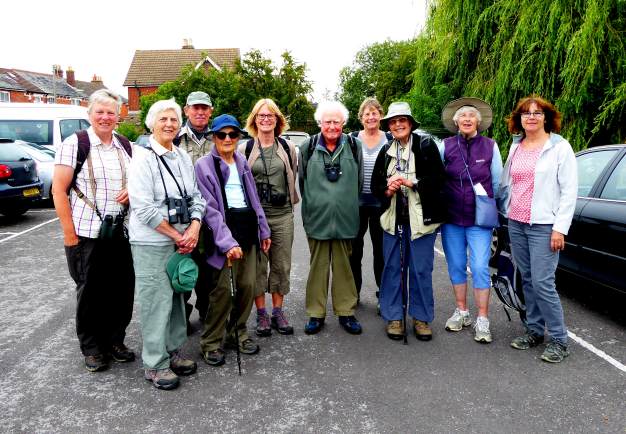
I have not attended
the walks for some years, but they are still going
strong under the leadership of Heather Mills. I always
publish the walk reports on the web site. Details of
the group which was originally started by Ralph
Hollins in 1995 can be seen on the dedicated pages at
. . . Havant
Wildlife Group
Railway
Wayside
Before going to Brook Meadow (as I revealed in
yesterday's blog) I had a little treat for the group.
We did a slight detour to visit the wayside behind
Emsworth Railway Station which currently hosts a fine
display of wild flowers. I think most members of the
group (apart from Caroline French) did not know the
wayside existed, so this was an eye-opener for them.
We walked up and down the access ramp at the rear of
the station from where the wayside could be viewed
easily. Young Caroline was agile enough to climb
through the fence onto the embankment to check out
individual plants. Here are some of the group on the
ramp looking at the wayside. Sorry my camera was on
the wrong setting for this photo.
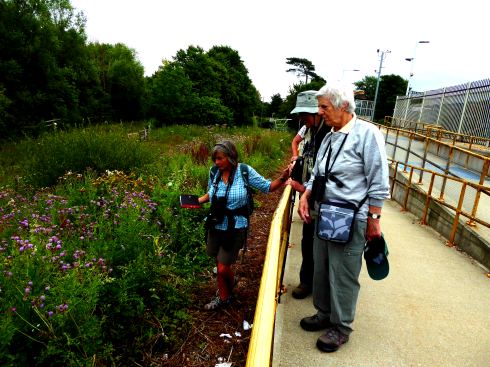
We paid particular
attention to the Marsh Woundwort flowers which
are the best anywhere in the local area. With the help
of Ros Norton we confirmed the identification of
Upright Hedge-parsley.
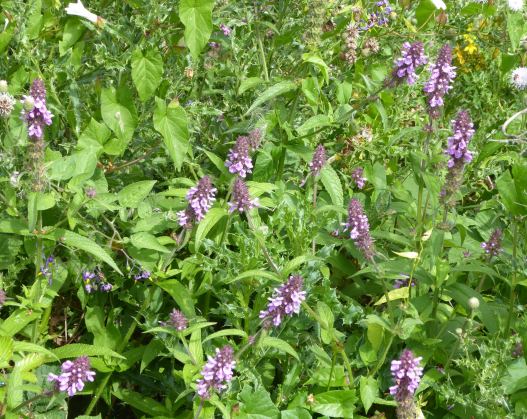
Brook
Meadow
Entering Brook Meadow through the Seagull Lane
gate we stopped to study the superb painting for the
interpretation board done by Marian Forster. The
original is on display in Emsworth Museum. Well worth
a visit, if only to see the painting.
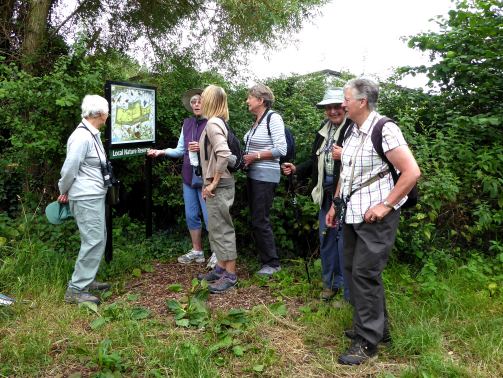
We also examined the
galls on the larger of the planted Oak trees and with
the help of Heather identified them as spangle and
marble galls. There were also other galls which we
were not sure about. We also looked at the other
smaller Oaks that were planted as saplings in 2012.
From the north bridge
we walked down the new ramp onto the meadow. Several
members sampled the aroma from the Meadowsweet.
Heather's sharp eyes
spotted a dead Ringlet in the vegetation near
the Lumley area, though some live ones were seen
later. (My photo below). We also came across lots of
Meadow Grasshoppers jumping around in the grass
(photo by Malcolm Phillips a couple of years ago).
At the Lumley entrance
we stopped to examine the plants in 'the Lumley
puddle' (now quite dry), including the tiny but robust
Toad Rush which Caroline held up for others to
see.
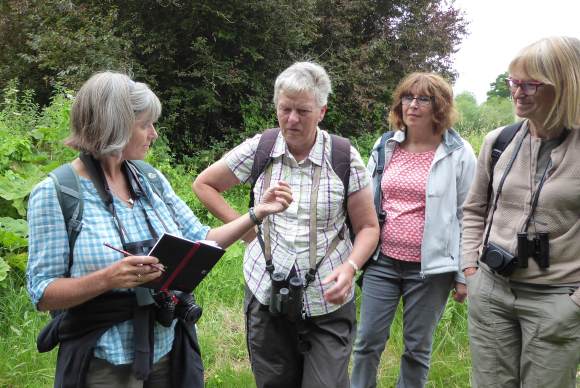
Heather spotted a Song
Thrush in the red leaved Cherry Plum tree on the
causeway, which I think Fay and others are looking
for.
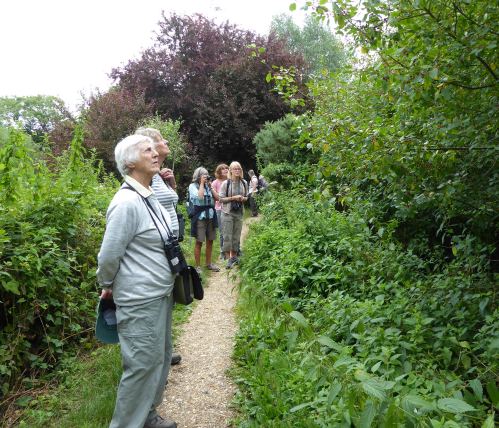
We did, in fact, get a
much better view of a Song Thrush and a young
Robin near the south gate. Photos by Derek.
Heather tried to make
friends with the Robin.
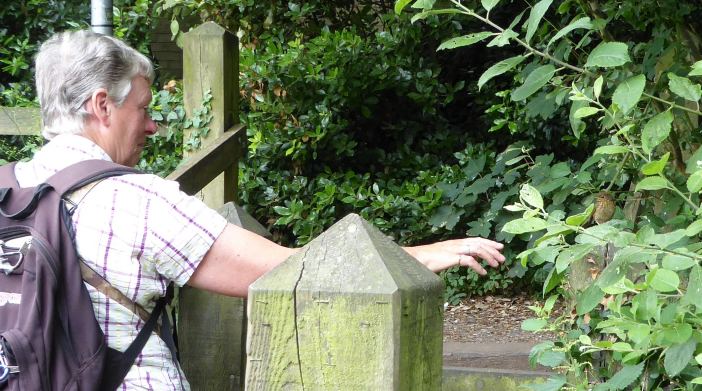
We stopped at the main
seat overlooking the meadow for coffee break. It just
so happened that Debbie Robinson (the group's
secretary) was set up there with sun shade and table
conducting a visitor survey. Debbie was delighted to
collect several £3 subscriptions from some people
who were not members which will help towards
maintaining the meadow in good order.
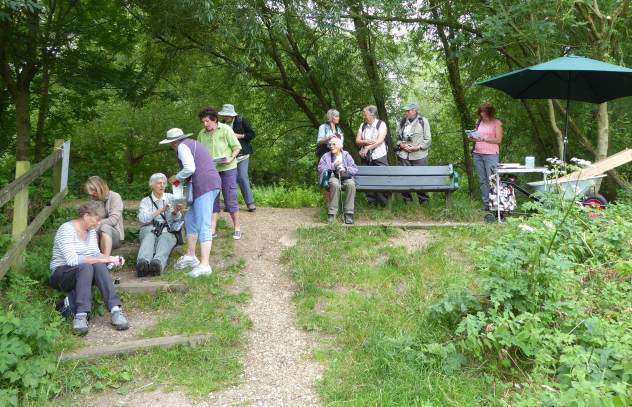
After the break we
walked down the new path by the Gooseberry Cottage
bund where we came across several
Bush-crickets. My photos were hopeless, but
Derek got a good one.
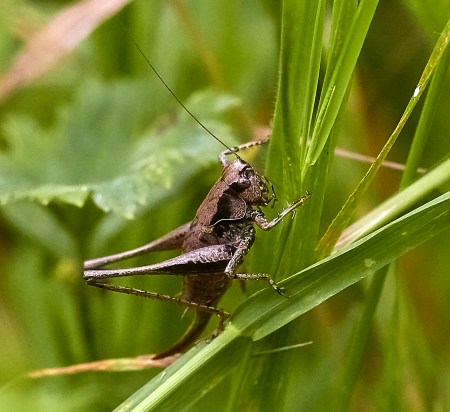
On the way back we met
David Search who had taken over the visitor survey
from Debbie. As David is our resident insect expert,
we consulted him about the Bush-crickets. He was not
sure at the time, but confirmed later that it was a
Dark Bush-cricket. David said something about
examining the genitalia which so shocked us, that we
all beat a hasty retreat!
David did have some
very interesting and surprising news that he had seen
two Kingfishers fly across the meadow while he
was on the seat. Wow! We were all very envious.
Kingfishers in summer are very rare in this area
(though common in winter). These may have been
youngsters dispersing from early broods further up
river.
Coming back along the main path we got a good view of
a male Beautiful Demoiselle by the river, which
had looked for but missed at the south bridge. My
photo.
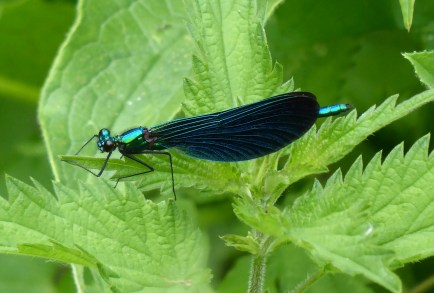
PS I have just
received the results of the visitor survey: 186
adults, 17 children, and 87 dogs went through the
meadow between 10am and 5pm.
FRIDAY
JULY 14 - 2017
Railway
Wayside
The wayside to
the north of Emsworth Railway Station is looking
great, a veritable blaze of colour from a multitude of
wild flowers. My camera does not do it justice. I wish
I was a poet. I think I shall include this wayside as
an aperitif for tomorrow morning's guided walk for the
Havant Wildlife Group though it is more of a meal in
itself! There will be no need for people to clamber
through the railings as the view from the access ramp
is fine.

Marsh Woundwort
is the botanical highlight of this site and there
are plenty scattered around on the embankment with a
particularly nice group at the top of the ramp.

Two plants I missed on
my last visit to this wayside were Agrimony -
in the far east of the wayside and Upright
Hedge-parsley. Upright Hedge-parsley is the latest
of the three common small white umbellifers to flower,
after Cow Parsley and Rough Chervil. It has very stiff
and rough stems with adpressed hairs and narrow
leaves.
I noted several Small
Skippers and Common Blues.
A group of Cinnabar
caterpillars were feasting on one of the Common
Ragworts. I also spotted a green Bush-cricket. My
tentative identification is Oak Bush-cricket,
though it could be a instar stage insect.
Bristly
Ox-tongue must be the wild flower of the week. It
is abundant on the Railway Wayside and is generally
widespread, even along pavements, like this one at the
top of Seagull Lane.

Brook
Meadow
Walking along
the north path by the railway embankment I noted a
good growth of False Brome (Brachypodium
sylvaticum) which, the name suggests, is a
grass associated with shady areas. It has softly hairy
leaves and long spike-like inflorescences drooping at
their tips. It differs from Barren Brome which has
very loose panicles with long branches drooping.

The red spikes of
Clustered Dock (Rumex
conglomeratus) were very prominent on the NE
path. I checked the fruits under the microscope and
all had three large red warts confirming the
identification.

I had a look at the
two experimental cutting areas on the north meadow,
the southern one of which has some interesting flowers
coming through, including Common Mouse-ear, Selfheal,
Red Bartsia and Jointed Rush.
The northern
experimental area is less promising as it remains
dominated by coarser tougher plants, such as Bristly
Ox-tongue and Tall Fescue. However, one bonus on this
area was a lovely view of a Marbled White
butterfly resting on a Bristly Ox-tongue leaf.

The Marsh
Woundworts that grow near the Weeping Willow tree
at the north end of the south meadow are doing well
this year, despite having to fight their way through a
mass of nettles and brambles. On 11 July, I counted 11
flowering spikes; today I counted 35 spikes and there
could have been more. This is the best number of Marsh
Woundwort spikes that I have counted at this location
since the plants were first recorded in Year 2012.
Maybe, I will have to make this one of my annual
counts?

From the south bridge
I got good views of male and female Beautiful
Demoiselles in courtship mode. It is interesting
how Beautiful Demoiselles have emerged as the main
damselfly of Brook Meadow, taking over from Banded
Demoiselles, which are seen less often now than they
used to.
A little way along the
path through the copse where there is access to the
river, I saw two male demoiselles, this time sparing
with one another. Also, at this vantage spot, I had my
first male Common Darter of the year, the first
of many I am sure.

Great
White Egrets
A mundane
visit to Langstone Mill Pond late this morning for
Peter Milinets-Raby turned into a long hike to Conigar
Point for distant views of 2 Great White Egrets. The
birds were picked up (through the scope) in the marsh
off Conigar Point. On 60 times magnification he could
just make out the hint of a yellow bill and the grey
bird next to them was a Grey Heron (this helped for
size comparison). Peter was thus forced to walk to
Conigar Point to try and get better scoped views which
he achieved, but the birds were further east than he
expected, probably being in the marsh adjacent to Nore
Barn. At one point the two birds were feeding next to
a Little Egret as well as the Grey Heron. Peter got
some 'dreadful record photos' - his description, not
mine! But they record these rare birds very well. Did
anyone else see them?
After walking back to
the pond, Peter quickly drove around to Nore Barn (1pm
to 1:10pm), but no sign of the Great White Egrets. All
he could see were 2 Shelduck, 2 Sandwich Tern and 4
Med Gulls.
Other species seen by Peter this morning (11:27am to
12:47pm - tide beginning to come in) were 22+
Redshank, 3 Med Gull and a Common tern. On the pond
were 60 Mallard and a Great Spotted Woodpecker. Off
Conigar Point were 2 Great Black-backed Gulls, a
Lesser Black-backed Gull, 1 Med Gull, 3 Common Tern
and a Swift.
Note on the Great
White Egret
Great White Egrets differ from the Little Egrets in
being considerably larger and also in having yellowish
legs and all yellow bill in non-breeding birds. Here
is a photo of a Great White Egret alongside Little
Egret taken by Richard Somerscocks at Thorney Great
Deeps in Feb 2012.

Until the 1990s the
Great White Egret was confined as a breeding species
to central Europe and Asia, but since then the
breeding population has expanded and with it the
number of birds wintering in Western Europe and in
Britain. They are less common in the summer months, so
these two at Nore Barn are very unusual. The Hampshire
Bird Atlas reported only 4 sightings in July in the
years 2007-12.
THURSDAY
JULY 13 - 2017
Hayling
Beach
Jean and I had
a very pleasant walk along Hayling beach this morning
from the car park east of the fun fair as far as
Beachlands. Great views of sea and sky with the faint
outline of the Isle of Wight in the distance.

There were as usual
plenty of gulls hanging around on the beach, waiting
for scraps of food from picnickers. Most were
Black-headed Gulls, but the odd Great Black-backed
Gull and Mediterranean Gull stood out
clearly.
The beach, in parts,
was carpeted with masses of Hare's-foot Clover,
though most of the flowers were past their best. I
checked some of the Wild Carrot umbels, some of
which (though not all by any means) had a red central
flower.
Almost all of the
Sea Kale is now fruiting, though some of the
Yellow-horned Poppies still had flowers.
Curled Dock
(Rumex crispus) - was abundant on the
shingle with its tall red spikes standing out
prominently. All the fruits I examined had 3 warts.
indicating that these plants were probably ssp.
littoreus which is more common near the
sea than ssp. crispus which usually has
only one wart. The photo through the microscope shows
two of the three warts on one of the fruits.
Lots of Bittersweet
(Solanum dulcamara) with flowers and
berries. I used to see this plant on the beach at
Hayling Oysterbeds, but was never sure if it was ssp.
marinum.

Prominent among the
grasses were dense clumps of Marram Grass - a
tall grass with long cylindrical panicles. Marram
Grass is famous for its ability to stabilise wind
blown dunes and it has been extensively planted around
the coast of the British Isles to achieve this end. It
also makes a very nice table decoration so I picked a
few stems to go in my display vases.

WEDNESDAY
JULY 12 - 2017
Bridge
Road
As I was
responsible for their presence, I decided to cut back
the Hollyhocks on the pavement in Bridge Road; they
were leaning right across the path causing people to
move into the road. There are still some flowers left,
though they are all going over. But it has been a
magnificent display and I am pleased I persuaded my
neighbours at No 1 to let them stay. Pavement flowers
at their best!

Brook
Meadow
Bristly
Ox-tongue is now in flower across the meadow,
particularly on the north meadow and centre meadow. It
is a favourite of mine, with its rough bristly leaves
and deep yellow flowers, tinged red. Bristly Ox-tongue
is the subject of a poem by Alice Oswald (in the book,
'Weeds and Wild Flowers'). This unglamorous plant is
portrayed as a solitary and curmudgeonly old man, "too
shy to speak . . . white hair uncombed . . . enormous
jaws, chewing on silence". All good stuff!

Wild Angelica
flower heads are a magnet for red Soldier Beetles.

There is a mass of
Fool's Water-cress growing in the river beneath
the south bridge. It is sometimes mistaken for edible
Water-cress, but it is quite a different plant. It is
an umbellifer and has flowers in white umbels. You can
see some flowers on the right of the photo. Its leaves
also differ from Water-cress being opposite and
slightly toothed.

The Alder sapling
that was planted near the Lumley Stream on 20 Aug
2015 now has a good crop of cones. Just after it was
planted the tree was infested with the larvae of the
Hazel Sawfly (Croesus septentrionalis)
which almost stripped all of its leaves. However, it
made a good recovery and is now in good health.

I scattered a few
Wild Clary seeds from the Christopher Way verge
on the ground in front of the main seat. It will be
interesting to see if any come up.
I was delighted to discover a good growth of Giant
Fescue on the path through Palmer's Road Copse,
just before the first large Crack Willow going north
from the bridge. It has been growing in this very spot
for the last 10 years at least and probably much
longer than that. This is, in fact, the only place it
grows on Brook Meadow that I am aware of. Giant Fescue
is the largest of the fescue grasses and is
distinguished by its loose drooping panicles and large
leaf-like auricles that clasp the stem, as illustrated
in the photos.
I was expecting it
here. This takes the total number of grasses recorded
this year on Brook Meadow to 23, though I have not yet
found any Meadow Barley. It is probably here
somewhere, but not in great amounts and never easy to
find. Enchanter's Nightshade is also flowering along
the path through Palmer's Road Copse.
Slipper
Millpond
The Great
Black-backed Gulls have finally left the pond. The
south raft where they nested is empty. The youngsters
must have fledged since I was last here.

I could only see 5 of
the original 6 cygnets in the Mute Swan family
in Dolphin Lake. Have they lost one?

TUESDAY
JULY 11 - 2017
Langstone
Mill Pond
Peter
Milinets-Raby had a wet visit to Langstone Mill Pond
this morning, the rain moving in for 30 minutes of his
50 minute stay from 9am. It was low tide.
The highlight was the first freshly fledged juvenile
Mediterranean Gull of the summer resting on the mud
off shore along with 25+ adults bathing and preening
before flying on to the Oysterbeds.

Also noted with them
were 3 adult Common Gull and one Lesser Black-backed
Gull. The other good bird of the visit were two Little
Terns that were dashing back and forth along the
channel, feeding along the tide line (my first
sighting this year of this declining species). Also of
note was a single Common Tern.
More waders were around today with 49+ Redshank and
two flocks of 18 Curlew heading west along the channel
towards Langstone Harbour. It's amazing, how the
numbers just build up very quickly once they
start!
On the pond was a single female Tufted Duck and I
counted 52+ Little Egrets still loitering. At least
three nests still held chicks of roughly two weeks
old.
MONDAY
JULY 10 - 2017
Waysides
News
I did a
circuit of the local waysides on what was a very warm
morning.
Washington
Road path
I started at the Washington Road path where I was
interested to see Balm in flower for the first time
this year. At the end of the path, just before the
entrance to the Recreation Ground, I stopped to admire
the very large plants of Greater Burdock
(Articium lappa) which regularly grow
here. The flower heads of these splendid plants
comprise a globular mass of hook-tipped bracts (the
burrs) surrounding a relatively small cluster of
reddish-purple florets which are just starting to
open.

Emsworth
Recreation Ground
I was
surprised to see that half the grassland behind the
bowling club has been cut, probably by the council.
This is a good idea as it will discourage course
grasses and stimulate late flowering. The uncut half
has the usual Creeping Bent and a good crop of what I
think is Smaller Cat's-tail (Phleum
bertolonii), though this grass is notoriously
difficult to distinguish from Timothy (Phleum
pratense). I tend to go on the overall size of the
plants, if it is big it is certainly Timothy, if it is
small it is probably Smaller Cat's-tail. The panicles
on the Recreation Ground grasses were mostly between
2cm and 4cm; the largest I could see was 6cm. Timothy
panicles are usually up to 15cm or more.

There is a good crop
of Creeping Thistles on the verge near the
northern fence of the recreation ground, but, as in
previous years, many of the plants are completely
blanched white. I have not been able to discover the
reason for this. It is not spraying as they come up
each year in exactly the same spot.

Christopher
Way
The official
wayside at northern end of Christopher Way has been
cut short by the council. Jane has fixed an
informative notice explaining that the grass is cut to
encourage Wild Clary. The small piece of grass verge
near the footpath entrance where the Wild Clary grows
has been left. Most of the Clary has now set seed, so
I collected some seeds for sowing in other areas, such
as Brook Meadow and Bridge Road.

I noticed a brown
Ladybird with many dark spots among the Wild Clary
plants. I am not sure what species it is, but it could
be one of the Harlequin Ladybirds.

New
Brighton Road Junction
The verge on
the junction has its usual good crop of Stone Parsley,
Mugwort, Common Ragwort, Bird's-foot Trefoil, Field
Bindweed, Spear Thistle. A variety of bees were
feasting on the Common Ragwort flowers.

Railway
Wayside
Just before I
got to the northern railway entrance, I stopped to
inspect the Wild Carrot umbels in front of the metal
gates on New Brighton Road on one of which I found a
yellow Crab Spider (Misumena
vatia) lurking in the centre. I watched with
tension as a fly landed on the head, wandered around a
bit and came dangerously close to the spider, but not
close enough for the spider to attack, while I was
there, at least!

The wayside embankment
close to the railway access ramp is a glorious blaze
of colour, pink, white, red, blue, quite spectacular.
Great Willowherb, Common Ragwort, Docks, Wild Carrot,
Hedge Bedstraw, Creeping Thistle, Yarrow, Perforate St
John's-wort. All this can be readily seen from the
ramp itself, though I got down onto the site for a
closer look.

I was especially
pleased to see lots of Marsh Woundwort flower spikes,
not only at the eastern end of the wayside near the
road where they were originally, but now scattered
around on the embankment. There is lots of Bristly
Ox-tongue, but mostly still in bud.

SUNDAY
JULY 9 - 2017
Nore
Barn
Jean and I
went for a walk to Nore Barn this morning. The tide
was high and lots of people were in the water and on
boats. I noted the usual flowering of Lax-flowered
Sea-lavender on the small area of saltmarshes on
the near side of the stream. This is not a good
picture, so you will have to take my word for it, or
better still go and have a look for yourself. Look out
also Lesser Sea-spurrey in this area.

Brook
Meadow
I went over to
the meadow this afternoon mainly to have a look at the
Marsh Woundwort that Maurice Lillie found
pushing its way through the jungle of vegetation at
the top of the Bramble path close to the Weeping
Willow. I counted 11 flowering spikes with more to
come; we should finish with about 20. Here is one of
the spikes I took. Not a good photo, but better ones
to come I hope.

I actually met Maurice
on the meadow taking photos. He told me about a
Beech tree he had discovered in the north-east
corner. This is the first Beech to be recorded on
Brook Meadow so will be added to our list of trees. It
is a fair sized tree growing right next to the large
pollarded Crack Willow at the far end of the north
path. I have not noticed it before!

Hemp Agrimony
is in flower a good 2 weeks earlier than usual. An
attractive White Plume Moth was resting on
Brambles.
SATURDAY
JULY 8 - 2017
Black-tailed
Godwits
Pete Potts
provided useful information about the Black-tailed
Godwits that Sue Thomas saw at Pagham Harbour
yesterday.

Pete says, "The vast
majority of birds present in the UK and on the south
coast from mid-may to the end of June are first summer
birds, hatched the previous season which do not return
to Iceland to breed till the following spring. There
are always a few adults in these flocks through the
summer which are either in poor condition or injured
in some way and so don't return north to Iceland to
breed.
Now, from the very end of June and through July ever
increasing numbers of failed breeders (adults) are
arriving back daily. The successful breeders return
probably from the end of July through August followed
by this years juvs from mid August onwards.
The birds breeding on the Washes are the limosa race
of Black-tailed Godwit as opposed to the islandica
race - these are quite rare on the south coast.
If you see any with rings on do please let me
know."
Coral
ornament
While browsing
through antique shops in Lewes on Friday, I came
across an attractive piece of white coral about 11
inches in height and mounted on a black base. I was so
taken with it that I bought it for £40. As well,
as being an attractive ornament, currently on display
in my study window, the coral is a natural object,
created by small marine invertebrates in tropical
seas.

But was I right to buy
it? As we all know, coral reefs are under stress
around the world, mainly from human activities, such
as harvesting. This makes me feel rather guilty about
having this lovely object on my desk, as in buying it
I have in a small way contributed towards the
degradation of the reefs. Can anyone put my mind at
rest? Or should I cover myself with sackcloth and
ashes?
Putting aside the
ethical issue for the time being I did a bit of
research on the coral itself. The label on the base of
the coral gives the name as Acropora
arcuata from the Celebes Sea in the Indian
Ocean. Acropora species are some of the major reef
corals responsible for building the immense calcium
carbonate substructure that supports the thin living
skin of a coral reef. Coral reefs are built by
colonies of tiny animals found in marine water that
contain few nutrients. Most coral reefs are built from
stony corals, which in turn consist of polyps that
cluster in groups. Coral reefs are mainly concentrated
in the oceans around northern Australia and Indonesia,
though there are many others scattered around the
word.
Portsdown
Hill
Ros Norton reported on this morning's walk by the
Havant Wildlife Group: They saw lots of butterflies
and the hill was ablaze with colours and flowers at
their peak.
Best of the
butterflies was this Essex skipper with black clubbed
antennae
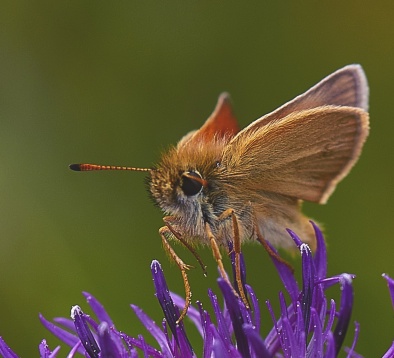
The best of the
flowers was this Lesser Centuary
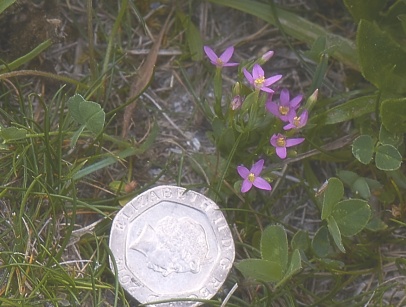
For the full report
and other photos see . . . http://familyfellows.com/hwg-walk-reports-2017.htm
FRIDAY
JULY 7 - 2017
Black-tailed
Godwits return
Sue Thomas saw
a flock of 35 Black-tailed Godwits in Pagham Harbour
this morning, in the lagoon behind the harbour wall.
Sue wonders what they were doing here as they should
be breeding in Iceland. Here is Sue's photo of a few
of them, some being in breeding plumage. They are such
elegant birds. My favourite wader.

My guess is that these
birds were the first returnees from the breeding
grounds in Iceland. The failed and non breeders tend
to return early and it is not unusual to see fairly
large flocks up to 100 assembling in our local
harbours. The most we have seen in Emsworth Harbour in
July is 97 on 7th July 2000. Though these seen by Sue
are particularly early. I will send Sue's sighting
onto Pete Potts our Black-tailed Godwit guru for his
comments.
Puss
Moth caterpillar
Caroline
French spotted this spectacular caterpillar at
Medmerry last Saturday. It was about 5 or 6cm long.
She was unable to identify it at the time but it was
finally identified as a Puss Moth caterpillar. This
one looks quite mauve but apparently they are quite
variable and can also look green. I see from my guide
that the moth itself is furry white with black spots.
What amazing variety there is in the natural world.

WEDNESDAY
JULY 5 - 2017
BROOK
MEADOW
Conservation Work
A group of 6th
Form students from from Bay House School in Gosport
came to Brook Meadow today with their teachers to
carry out out some conservation work as directed by
Jennifer Rye. I was not present, but went later to see
the results of their work which were very impressive.
They completed two main jobs. One was to extend the
path area immediately outside the HQ tool store to
allow for easier access for the power scythe. The
other one was to construct steps in the north-east
corner of the meadow from the path down to the river.
This was to make it easier for people to exercise
their dogs in this dedicated splash zone. Pam Phillips
was making good use of it while I was there.
Tree surgeons from the
Christopher Hoare Tree Services were on the meadow
yesterday to cut up a couple of large fallen Crack
Willow trees in the south meadow. They did a good job
and neatly stacked the logs. They also lopped some of
the tall Willows behind the tool store on the Seagull
Lane patch and again stacked the resulting logs
neatly. A good job well done. Many thanks also to HBC
arborist Andy Skeet for organising it.
Wildlife
observations
I was pleased
to see my first Small Skippers of the year on Brook
Meadow. This takes the total number of species
recorded on Brook Meadow so far this year to 17.

I was also pleased to
spot a very good growth and flowering of Blue
Water-speedwell (Veronica
anagallis-aquatica) near the reeds on the west
bank of the river north of the sluice gate. The flower
spikes did not appear over long, which suggests this
maybe the pure species and not the hybrid
(Veronica x Lackschewitzii)

Ants
flying day
Hundreds of
gulls were swirling around in the sky this afternoon
gobbling up ants. Clearly, this was the perfect day
for the local ant colonies to begin the 'nuptial
flight' period of their reproduction cycle. Other
colonies will choose different days. Apparently, they
fly some distance to start new colonies - this avoids
inter breeding. The photo shows just a small section
of sky.

New
contact for TCV
Rachel Moroney
(now Bryan) has been our main contact and good friend
from the Trust for Conservation Volunteers for many
years, but she has a new job within the TCV. She will
be the Operations Leader for England West, which means
managing staff and offices in Southampton, Reading,
Bristol and Gloucester. Rachel says it has been a
pleasure working with all the conservation groups in
the local area and hopes to visit on occasions. I
think I speak for all the Brook Meadow Conservation
Group when I say it has been our pleasure to work with
you Rachel, always so helpful and friendly. We wish
you all the best in your new job. Here is a photo of
Rachel with the Brook Meadow Conservation Group at the
start of a workday in June last year.

Meanwhile, the new TCV
contact for the local conservation groups, ie, review
visits, conservation forum and general advice and
support will be Colette Court. Her email
address is colette.court@tcv.org.uk We look forward to
meeting Colette.
Rachel also provided the name of a new contact within
Norse SE for payment of TCV membership & Zurich
insurance renewal as Chris Haynes . . .
chris.haynes@ncsgrp.co.uk
Shelducks
on the move
Shelduck are a
familiar feature of estuaries and other coastal sites
in north western Europe. The species has a fascinating
breeding biology, and is the only waterbird in the
region to regularly nest in burrows. Parents can be
seen with chicks from late May onwards.
In July, the majority of the adults leave for moulting
sites in the eastern North Sea. Up to 300,000 birds
from across Europe take part in this moult migration
and remain until September when they return to their
regular wintering quarters, including Langstone and
Chichester Harbours.
The following BTO link shows a map based on ringing
recoveries which vividly illustrates this movement.
http://bto-enews.org/NXN-50HXD-3GJW16-2P1VK4-0/c.aspx
TUESDAY
JULY 4 - 2017
Bird's-foot
Trefoils
As I was
walking down the Hayling Billy Line on June 30th I
came across some Bird's-foot Trefoil that did not look
right for Common Bird's-foot-trefoil. The flowers were
all yellow, it was quite erect and the leaves looked
thin. This set me thinking about the possibility of
alternatives, such as, Greater Bird's-foot Trefoil, or
even Narrow-leaved Bird's-foot Trefoil. Here is the
photo I took of one of the plants.

Ecologist John Norton
replied to say the plant was definitely Common
Bird's-foot Trefoil. He said this often has moderately
elongated leaflets below the flowers, but it was the
lack of hairs on the plant that ruled out Greater
Bird's-foot Trefoil, while Narrow-leaved Bird's-foot
Trefoil (Lotus glaber/tenuis) would have
much longer and narrower leaflets.
The identity question
was reopened by Ralph Hollins who told me that he
found some Greater Bird's-foot Trefoil yesterday near
the west end of the Mengham Junior School site on
Hayling Island which he thought looked very similar to
the plant in my photo. Ralph took a specimen of his
plant home and confirmed the id of Greater Bird's-foot
Trefoil by cutting through the main stem to ensure
that it was hollow; Common Bird's-foot-trefoil would
have a solid stem.
To try to resolve this
issue, this morning went to the Hayling Billy Line and
have another look at the Bird's-foot Trefoil that I
found there last week. The plants were easy to find a
little way down the main track from the northern car
parking area. Interestingly, some of the plants had
pods arranged in a bird's foot pattern from which the
plants get their common name.

I cut a couple of
specimens and they certainly had tough, solid stems.
The plants were also largely hairless and the calyx
teeth were not reflexed as they would have been in
Greater Bird's-foot Trefoil. So, it looks as though
John was right, the plants are Common
Bird's-foot-trefoil and not Greater Bird's-foot
Trefoil.
Interestingly, I found
this photo in my files taken several years ago at
Newtown Nature Reserve on the Isle of Wight showing
examples of both Common Bird's-foot-trefoil (left) and
Greater Bird's-foot Trefoil (right). Clearly the
latter is very hairy. These were confirmed by the
reserve warden.

Back to today, coming
back to the car park along the Hayling Billy Line,
where the cycle track veers to the right , I took the
path straight on that originally carried the train
line across the harbour to Havant. It was here, with
Bird's-foot Trefoils prominently in my mind, that I
got quite excited by another scrambling
yellow-flowered plant with narrow leaves. Surely, not
Narrow-leaved Bird's-foot Trefoil? Closer inspection
revealed the presence of tendrils and leaflets in
pairs not trios. This was Meadow Vetchling.

I also observed a Wild
Carrot plant with pink hued umbels, one of which was
heavily populated with red Soldier Beetles
(Rhagonycha fulva).

Langstone
Mill Pond
Peter
Milinets-Raby popped down to Langstone Mill Pond this
afternoon from 1:52pm to 2:34pm. Still not much
around. It was low tide. The highlight was the first
freshly fledged Black-headed Gull wandering around the
low tide mud. Such ginger brown things, very odd!
Off shore were 2 Black-tailed Godwit with 8+ Curlew
and a single Common Tern. On the pond were 36+ Little
Egrets, mostly juveniles, some still small and in
their nests. 4 Grey Heron (all juvs), Reed Warbler and
Chiffchaff still singing
MONDAY
JULY 3 - 2017
Slipper
Millpond
As I stood on
the Hermitage Bridge by Slipper Millpond, the Mute
Swan family with 6 cygnets went sailing by. They look
really healthy. Less happy was the forlorn looking
pair of Coot near the west path - yet another breeding
season gone with no youngsters to look after.

As for the two
Great Black-backed Gull chicks, they were alone
on the south raft.

However, I spotted one
of their parents on a chimney pot on Slipper Road,
keeping an eye on them. I got the impression that the
adult was trying to encourage the chicks to fly.

While I was taking
photos of the chicks from the west path this adult
swooped down low, right over my head. This was the
first time I have been 'buzzed' this year, though it
has happened in previous years. Quite scary!
Fox
and Cubs
The small
grass verge at the far end of Church Path once again
hosts a superb display of Fox and Cubs flowers. This
is, by far, the best display of these attractive
flowers that I am aware of in Emsworth.

Fox and Cubs (aka
Orange Hawkweed) gets its name from the rusty orange
mature flower (the fox) and its flanking buds with
fuzzy blackish hair (the cubs).

It was introduced into
Britain from Central Europe in the 17thC and since
then has become widely naturalised. It grows well in
churchyards, verges and other grassy places. The verge
in Church path is privately owned and contractors cut
it frequently, but the flowers seem to benefit from
this cutting, for they pop up in this fine display
every year in July.
Other
local news
Brian Lawrence had a walk around Brook Meadow today.
There were a few butterflies about not much else. So
he went down to Slipper Millpond and saw one of the
Great Black-backed Gull chicks fly a short distance.
There was also a Mallard with 4 ducklings. And the
best of British luck! Finally, Brian then went up
Lumley under the A27 road where he had Cinnabar moth
caterpillars on Common Ragwort. Lovely grub.
Conigar
Point
Peter
Milinets-Raby parked himself on the shoreline by
Conigar Point and watched the tide drop from 9:03am to
10:54am.
"Apart from lots of exposing mud, I had a few Med
Gulls. The Med Gulls were obviously returning from
their morning hunting sessions inland as they flew
over in one and twos and briefly dropped in to the
stream for a quick two minute drink before moving on
to the Hayling Oyster beds. I had in total of 23
birds, with three being the maximum at any one time.
(see photos)
Adult and second
summer Med Gulls
Also dropping in for a
wash as the tide fell away were 2 pairs of Shelduck, a
Curlew, 10 Lesser Black-backed Gulls, though three
together were the highest encountered and over 30+
Herring Gulls.
Other species of note were 3 Common Tern and a
Sandwich Tern.
In the Tamarisk hedge and the mini reed bed, I heard
singing Reed Warbler and 2+ Whitethroats and saw a
Chiffchaff (probably the first of the
autumn).
Chaffinches
in decline
The British
Trust for Ornithology says this spring saw the lowest
ever numbers of Chaffinches in gardens as reported by
the Garden BirdWatch participants. I have also noticed
a similar trend in my own garden here in Emsworth
where Chaffinch numbers have been falling for several
years. Here are my weekly average count of Chaffinches
in the garden over the whole year. Numbers go up and
down, but it shows very poor counts for Years 2014,
2016 and 2017 so far.
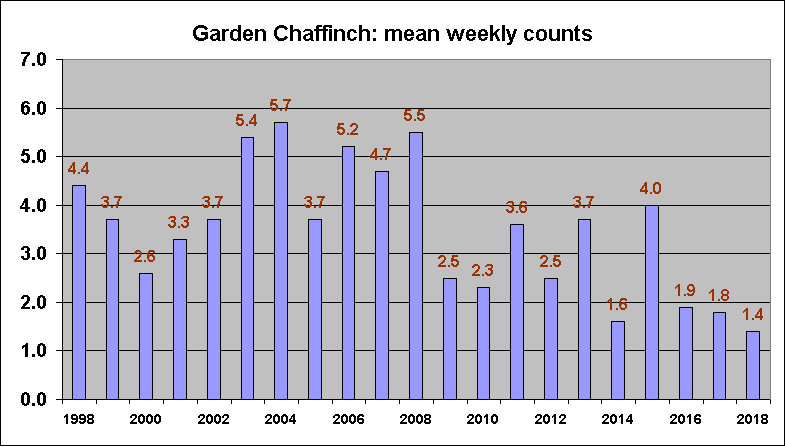
This trend is also
seen in wider countryside, with the Breeding Bird
Survey reporting a decline in Chaffinches over the
last ten years. They don't know the reason for this
decline but one line of investigation is the disease
Trichomonosis which has caused large declines in the
Greenfinch population.
See . . . http://bto-enews.org/NXK-50KA4-3UEDCR-2OTC65-0/c.aspx
Finally, they urge all
garden birdwatchers to regularly clean feeders and
bird baths and to report any sick or dead birds to the
Garden Wildlife Health project at http://bto-enews.org/NXK-50KA4-3UEDCR-2OTC66-0/c.aspx
Red
flower in Wild Carrot
I posted the
photo of the Wild Carrot umbel with the red flower in
its centre that I took on Slipper Millpond on June 29
to the Wild Flowers group on Facebook with a query. Is
this an aberration? Well, this posting provoked a long
and interesting discussion from which I give some
extracts which might be of more general interest. Here
is the original photo.

Rob Large (the group
guru) replied to say that the central red flower it is
not an aberration, but neither is it the norm (though
it is normal), or truly characteristic of the species.
He thinks it may be locally common for some umbels to
have the red flower, but in his experience in the west
country and elsewhere it hardly ever occurs. However,
other correspondents from across the country did
report having seen the central red flowers on many
Wild Carrots, so maybe it is a local variation?
Rob rapped the
knuckles of one correspondent who suggested that
'evolution has put the red flower there for a reason,
perhaps to attract a certain type of insect'. Rob
replied, "That
is not how evolution works. Rather evolution has
failed to eliminate this minor variation in the
phenotype because it does not confer a survival
disadvantage. If there was an advantage in having the
red central flower (never ever call it a reason) then
all (or most) plants would have
it."
Finally, Rob added,
"The
white flowered umbellifer is an exceptionally
efficient form for pollination and Daucus (Carrot)
typically exhibits close to 100% seed set in most
environments. Hence, it is hard to believe that there
is even a marginal benefit to a single red flower in
attracting pollinators. I understand that the red one
is usually sterile anyway. Given that the flowers in
bud are typically red/pink, perhaps it has more to do
with the development process itself, with red pigments
being progressively withdrawn as the flowers open from
the outer edge, until the concentration of pigment at
the centre actually prevents proper
flowering."
The next interesting
contribution came from Ellen Lamborn who had done some
research on the red central flower as an undergraduate
project and got the findings published! Ellen says,
"I
studied the theory that dark central floret was a
'fly' (or insect) attractor, but we didn't find any
significant effects. I believe this has been studied
since by other authors who concluded that certain
beetles were attracted to the floret, but in
populations in Portugal."
The paper concluded
thus: "The
role of the dark central floret remains an enigma. We
speculate, following Darwin, that the dark central
floret may now be functionless and possibly represents
a trait that has persisted long after its original
function has been lost."
See link to Ellen's paper at . . . http://onlinelibrary.wiley.com/doi/10.1046/j.1365-2435.2000.00440.x/full
In response to Ellen's
research, I had a close look at the Wild Carrots
during a walk along the old Hayling Billy Line on June
30. The first one I saw, close to the car park, had
several large white umbels, each one of which had a
red central flower. There were lots of flies on the
umbels and I got the distinct impression thy were
attracted to the central red flowers, though they did
not seem to feed. Here is a photo taken then showing a
fly approaching the central flower.

Ellen Lamborn agreed.
In her research the red central flowers were attacked
by Sawflies, but there was no significant difference
in seed set, ie there was no clear advantage for the
plant from the flies attention.
Finally, Mike Crewe
replied as follows, "Since
the benefits of attracting insects to an insect
pollinated plant are obvious and since this mechanism
is well known in other plant groups, it seems a fair
assumption that the red flower helps attract insects,
probably by indicating (falsely) that there is already
an insect there so a visit would be worthwhile. Two
thoughts on the presence/absence variability noted:
the red flower may only be functionally present at the
optimum time for attracting insects and may simply
appear to be absent at other times. Alternatively,
since insect populations fluctuate widely year on year
(both in number and in species composition) it may
suit the plant to have this mechanism only available
in a percentage of the population for a variety of
reasons."
SUNDAY
JULY 2 - 2017
BROOK
MEADOW
Work Session
I went over to
the meadow this morning for the regular 1st Sunday in
the month conservation work session. Ten volunteers
attended led by Jennifer Rye who outlined the various
tasks for the day. These involved mainly cutting and
clearing the paths and some of the special areas,
including the new 'recreation area' in the north
meadow near the large fallen Crack Willow tree. This
is becoming a rather nice glade.

The full report and
more photos can be seen on the Brook Meadow web site
at . . . http://www.brookmeadow.org.uk/conservation-news/
Wildlife
news during the morning
Birds singing
included Blackbird, Wren, Blackcap and Chiffchaff. I
was pleased to see the first Gatekeepers and Marbled
White. That takes the total number of butterfly
species seen on Brook Meadow this year to 16 (out of
site total of 26). Azure Damselfly in the south
east corner.

My best sighting was a
Birch Sawfly near the south gate - see below.
Broad-leaved
Everlasting-pea - has managed to battle its way
through the jungle of vegetation on the Seagull Lane
patch. This attractive flower has been regular at this
location for many years, but as I did not see it at
all last year I thought we may have lost it. But, no!
Here it is again.

Perforate St
John's-wort - one plant in flower on the edge of
the Lumley area. This was my first sighting on the
meadow since 2014. Square-stalked St John's-wort is
far more common.
The small Oak sapling planted by my wife Jean
on the Seagull Lane patch as part of the Jubilee
celebrations in 2012 has been cleared and is look in
very good health. Here's to the next 300 years!

Tony Browne told me
that he thought he saw a Leech while clearing
out the Lumley Stream in front of the Lumley Cottages
where he lives. Brenda Scott reported seeing a
Cinnabar Moth.
Birch
Sawfly
The most
interesting sighting of the morning was a large
handsome insect which I saw while I was chatting to
Dave Lee. It was perched on the gate post at the south
entrance, but obligingly crawled onto my hand where I
was able to get this nice photo. Neither of us knew
what it was, but looking it up in my insect guide I
identified it as Birch Sawfly (Cimbex
femoratus). Interestingly, there is a Birch
tree close to the south gate where I found this
insect.

The adult Birch Sawfly
is best recognised by the pale band on its shiny black
abdomen. Its wings are smoky brown colour with dark
brown margins and the antennae are clubbed yellow
tipped. The Birch Sawfly is also large; at up to 25mm
long, it is the largest British Sawfly. It buzzes in
flight, though it did not have a chance to fly. In
fact, I had difficulty in getting it off my hand as it
clung on tenaciously. Its UK status is said to be
local throughout Britain, so not very common.
The solitary larvae feed on Silver Birch leaves
between June and September and can grow up to 45mm in
length. A black edged bluish stripe runs along the
middle of the larva's back for the length of its body.
There is a single row of black dots along the side of
the body.
Identification
Updates
Bryan Pinchen
confirmed that both the Skippers I saw recently, one
on the Railway Wayside in Emsworth and the other on
the Hayling Billy Line, were correctly identified as
Essex Skippers. That is brilliant. The best
view I have ever had of these elusive
butterflies.
However, John Norton
said the Bird's-foot Trefoil that I found on
the Hayling Billy Line that I thought might be Greater
Bird's-foot Trefoil or Narrow-leaved Bird's-foot
Trefoil was definitely Common Bird's-foot Trefoil. He
says, "It often has moderately elongated leaflets
below the flowers. The lack of hairs rules out all the
other species other than Lotus glaber/tenuis, but that
has much longer & narrower leaflets.

For
earlier observations go to . . . June
17-30